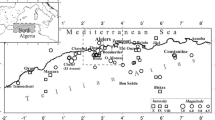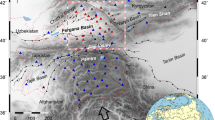Abstract
We used both seismic and InSAR data to investigate the mechanism behind the 2011 Hawthorne (Nevada) earthquake swarm that occurred between March 15 and August 17, 2011. Regional seismic data were used to estimate the centroid depth and focal mechanism for nine earthquakes that occurred in this swarm, with magnitudes between \(M_w\)3.9 and \(M_w\)4.8. The inferred focal mechanisms indicate that the source of these earthquakes is normal faulting with a small left-lateral strike-slip component along the southwest direction. Three InSAR displacement maps covering the epicentral zone of the 2011 Hawthorne earthquakes were inverted to get a slip model. The slip distribution shows that the deformation source is characterized by normal faulting, consistent with our inferred focal mechanisms. Our results suggest that the seismogenic zone was in the tensile stress environment. The temporal and spatial evolutions of seismicity suggest that the 2011 Hawthorne swarm might be caused by aseismic slip. Therefore, the 2011 Hawthorne earthquake swarm may have been the result of aseismic slip under the regional tectonic stress, and had nothing to do with volcanic activity. However, the quantitative evidence for aseismic slip is limited to the indication that the geodetic moment is 15% greater than the seismic moment, which is near the level of uncertainty.








Similar content being viewed by others
References
Bassin C, Laske G, Masters G (2000) The current limits of resolution for surface wave tomography in North America. EOS Trans AGU 81:F897
Bennett RA, Wernicke BP, Niemi NA, Friederich AM, Davis JL (2003) Contemporary strain rates in the northern Basin and Range province from GPS data. Tectonics https://doi.org/10.1029/2001TC001355
Bormann JM, Hammond WC, Kreemer C, Blewitt G (2016) Accommodation of missing shear strain in the Central Walker Lane, western North America: constraints from dense GPS measurements. Earth Planet Sci Lett 440:169–177. https://doi.org/10.1016/j.epsl.2016.01.015
Bormann JM, Surpless BE, Caffee M, Wesnousky SG (2012) Holocene earthquakes and late Pleistocene slip rate estimates on the Wassuk Range fault zone, Nevada, USA. Bull Seismol Soc Am 102(4):1884–1891
Cheng G, Wang H, Luo Y, Guo H (2015) Study of the deformation mechanism of the Gaoliying ground fissure. Proc IAHS 372:231–234
Dziewonski AM, Chou T-A, Woodhouse JH (1981) Determination of earthquake source parameters from waveform data for studies of global and regional seismicity. J Geophys Res Solid Earth 86(B4):2825–2852. https://doi.org/10.1029/JB086iB04p02825
Gibowicz SJ, Kijko A (1994) An introduction to mining seismology. Academic Press, New York
Hammond WC, Thatcher W (2007) Crustal deformation across the Sierra Nevada, northern Walker Lane, Basin and Range transition, western United States measured with GPS, 2000–2004. J Geophys Res https://doi.org/10.1029/2006JB004625
Hill DP, Pollitz F, Newhall C (2002) Earthquake–volcano interactions. Phys Today 55:41–47. https://doi.org/10.1063/1.1535006
Holtkamp SG, Pritchard ME, Lohman RB (2011) Earthquake swarms in South America. Geophys J Int 187(1):128–146. https://doi.org/10.1111/j.1365-246X.2011.05137.x
Horton SP, Norris RD, Moran SC (2008) Broadband characteristics of earthquakes recorded during a dome-building eruption at Mount St. Helens, Washington, between October 2004 and May 2005, chapter 5, pp 97–110. U.S. Geological Survey Professional Paper
Ichinose GA, Anderson JG, Smith KD, Zeng Y (2003) Source parameters of eastern California and western Nevada earthquakes from regional moment tensor inversion. Bull Seismol Soc Am 93(1):61–84. https://doi.org/10.1785/0120020063
Lange R, Carmichael IS (1996) The Aurora volcanic field, California-Nevada: oxygen fugacity constraints on the development of andesitic magma, vol 125, chapter 2–3, pp 167–185. Contributions to Mineralogy and Petrology
Lu Z, Wicks C, Dzurisin D, Power J, Moran S, Thatcher W (2002) Magmatic inflation at a dormant stratovolcano: 1996–98 activity at Mount Peulik volcano, Alaska, revealed by satellite radar interferometry. J Geophys Res 107(B7):2134. https://doi.org/10.1029/2001JB000471
NCEDC (2014) Northern California earthquake data center. UC Berkeley seismological laboratory, dataset. https://doi.org/10.7932/NCEDC
Okada Y (1985) Surface deformation due to shear and tensile faults in a half-space. Bull Seismol Soc Am 75(4):1135–1154
Press WH, Flannery BP, Teukolsky SA, Vetterling WT (1992) Numerical recipes in FORTRAN: the art of scientific computing, 2nd edn. Cambridge University Press, Cambridge
Reeves JA, Knight R, Zebker HA (2014) An analysis of the uncertainty in InSAR deformation measurements for groundwater applications in agricultural areas. IEEE J Sel Top Appl Earth Obs Remote Sens 7(7):2992–3001. https://doi.org/10.1109/JSTARS.2014.2322775
Roland E, McGuire JJ (2009) Earthquake swarms on transform faults. Geophys J Int 178(3):1677–1690. https://doi.org/10.1111/j.1365-246X.2009.04214.x
Shelly DR, Beroza GC, Ide S (2007) Non-volcanic tremor and low-frequency earthquake swarms. Nature 446(7133):305–307. https://doi.org/10.1038/nature05666
Shelly DR, Hill DP, Massin F, Farrell J, Smith RB, Taira T (2013) A fluid-driven earthquake swarm on the margin of the Yellowstone caldera. J Geophys Res Solid Earth https://doi.org/10.1002/jgrb.50362
Smith K, Johnson C, Davies J, Agbaje T, Knezevic Antonijevic S, Kent G (2011) The 2011 Hawthorne, Nevada. Earthquake Sequence; Shallow Normal Faulting, AGU Fall Meeting Abstracts
Tuffen H, Smith R, Sammonds PR (2007) Evidence for seismogenic fracture of silicic magma. Nature 453:511–514. https://doi.org/10.1038/nature06989
USGS (2018) Search Earthquake catalog, Earthquake Hazards Program. https://earthquake.usgs.gov/earthquakes/search
Vidale JE, Shearer PM (2006) A survey of 71 earthquake bursts across southern California: exploring the role of pore fluid pressure fluctuations and aseismic slip as drivers. J Geophys Res https://doi.org/10.1029/2005JB004034
Wegmüller U, Werner C (1997) Gamma SAR processor and interferometry software. In: Proceedings of 3rd ERS symposium, pp 1687–1692, Florence
Wesnousky SG (2005) Active faulting in the Walker Lane. Tectonics https://doi.org/10.1029/2004TC001645
Wesnousky SG, Bormann JM, Kreemer C, Hammond WC, Brune JN (2012) Neotectonics, geodesy, seismic hazard in the northern Walker Lane of western north America: thirty kilometers of crustal shear and no strike-slip? Earth Planet Sci Lett 329–330:133–140. https://doi.org/10.1016/j.epsl.2012.02.018
Weston J, Ferreira AM, Funning GJ (2012) Systematic comparisons of earthquake source models determined using InSAR and seismic data. Tectonophysics 532–535:61–81. https://doi.org/10.1016/j.tecto.2012.02.001
Wood C, Kienle J (1992) Volcanoes of North America: United States and Canada. Cambridge University Press, Cambridge
Zhao L-S, Helmberger DV (1994) Source estimation from broadband regional seismograms. Bull Seismol Soc Am 84(1):91–104
Zhu L, Ben-Zion Y (2013) Parametrization of general seismic potency and moment tensors for source inversion of seismic waveform data. Geophys J Int https://doi.org/10.1093/gji/ggt137
Zhu L, Helmberger DV (1996) Advancement in source estimation techniques using broadband regional seismograms. Bull Seismol Soc Am 86(5):1634–1641
Zhu L, Rivera LA (2002) A note on the dynamic and static displacements from a point source in multilayered media. Geophys J Int 148(3):619–627. https://doi.org/10.1046/j.1365-246X.2002.01610.x
Acknowledgements
We also thank Charles W. Wicks of U.S. Geological Survey for his technical guidance in the deformation inversion. This work was supported by grants from the Natural Science Foundation of China (No. 41374037), the Fundamental Research Funds for Central Universities (Nos. WK2080000053 and WK2080000078) and the SRF for ROCS, SEM (No. WF2080000021).
Author information
Authors and Affiliations
Corresponding author
Electronic supplementary material
Below is the link to the electronic supplementary material.
Rights and permissions
About this article
Cite this article
Zha, X., Jia, Z., Dai, Z. et al. The cause of the 2011 Hawthorne (Nevada) earthquake swarm constrained by seismic and InSAR methods. J Geod 93, 899–909 (2019). https://doi.org/10.1007/s00190-018-1212-5
Received:
Accepted:
Published:
Issue Date:
DOI: https://doi.org/10.1007/s00190-018-1212-5




